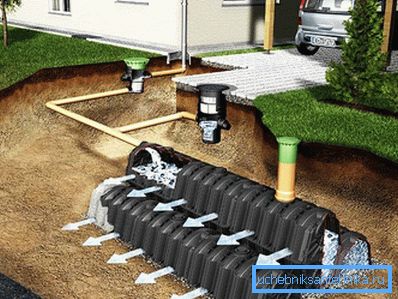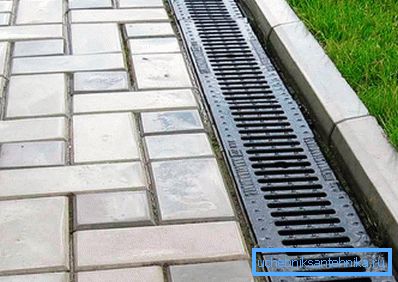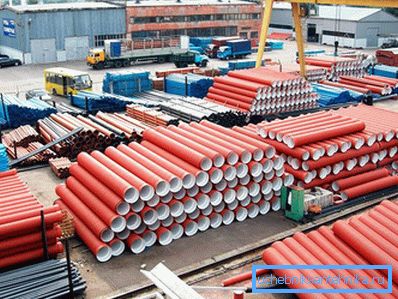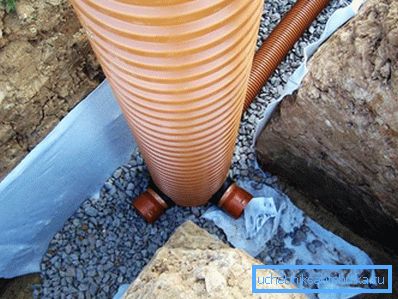Pipes for storm sewers: how to choose
The owners of country houses are always a lot of trouble. It is necessary to keep the land clean and tidy, monitor the condition of the house and buildings, to ensure the work of all communications. Among these matters, not least is the concern for rainwater diversion. If you do not approach this issue with all seriousness, then the site and the buildings on it will soon become unusable.
A little about the system itself

Before you begin the selection of pipes for storm sewers, it is worth a little to familiarize yourself with the system itself. Its main task is the removal of rain and melt water from the site. As a rule, such a system is installed if there is frequent precipitation in the area, and the territory of a country site is located in a valley or on waterproof ground.
Tip! So that the water does not wash away the foundation of the structure and does not turn the site into a marsh, it is removed by stormwater into a natural reservoir, drain, or drainage.
The storm sewer system is of two main types:
- open - in this case, gutters and chutes are installed in the right places, along which water is drained off the site;
- closed - this option involves laying pipes in the ground. They are drained through sewers.

Both in the first and in the second version pipes are used. Only with an open system, they are used only in certain areas, whereas in a closed one almost everywhere. Since the pipes can be laid both in the ground and on the surface, they must have certain characteristics, which will be discussed further.
Specifications

Pipes for any communications must comply with the conditions in which they will operate. Exactly the same can be said about the products for storm sewer. Such pipes can be used both for laying outside and for laying in the ground; they must meet the following requirements:
- Strength. Such pipes must withstand mechanical stress in the form of shock, compression, bending, etc. These products are stacked for several decades, so they should easily withstand the entire lifetime.
- UV tolerance. Since part of the pipes will be laid on the surface, they must withstand exposure to sunlight. Otherwise, leaks will constantly occur in some areas.
- Immunity to aggressive reagents. Rain and melt water will flow through the pipes. If in the first - “chemistry” is not enough (of course, if you don’t live near the chemical plant), then there may be too many different elements in the drains arising from melting snow.
- Resistance to temperature extremes. Pipes will be in place in winter and summer. Moreover, in spring, the difference between day and night temperatures can be quite substantial.
Knowing all the requirements for such products, you can get acquainted with the options used in their production materials. And, having made comparisons, to make a choice.
Materials for production

As the material in the manufacture of pipes can be used various raw materials. Each option has its advantages and disadvantages:
- Cast iron. Such pipes have recently been very popular. Cast iron is not afraid of temperature changes, it is quite durable and is not exposed to the "chemistry". But such material has its own, and significant, disadvantages. First, the cast iron is very heavy. This circumstance greatly complicates the transportation and installation of pipes. Secondly, cast iron products are expensive, which also reduces their popularity.
- Various polymers. This group includes materials such as HDPE, PVC, polypropylene and many other plastics. Such pipes are quite strong and durable. In addition, they have a water-repellent inner surface. This circumstance significantly reduces the risk of blockage. In addition, PVC pipes and similar to them are light, and they are much cheaper than cast iron products. The only disadvantage is that cheap plastic can not be put under the road, as it can not withstand a large load from the car. For laying under the road you need to purchase reinforced corrugated pipes.
- Reinforced concrete pipes. Such products are rarely used for storm sewers. Reinforced concrete is quite heavy and difficult to install. But it is these pipes that are best suited when you need to lay a pipeline under the roads.
- In some literature you can find quite exotic materials. For example, the use of ceramic products. But this option is almost never found. Ceramics is quite expensive, and such material is not famous for its great strength. Ceramic pipes can be used to improve the appearance of the site. Of course, if finances permit.
Corrugated pipes

One of the most common materials for creating plastic pipes for various sewers can be considered polyethylene. But a significant drawback of such products is the inability to effectively withstand high compression loads. But the pipe lying in the ground, constantly under great pressure.
The way out of this difficult situation was the invention of corrugated double-layer pipes. This design has a corrugated outer layer and the inner one, made absolutely smooth. As a result, the resistance to compression has increased, and at the same time the smooth internal surface ensures the free flow of liquids, which reduces the risk of formation of blockages.
Double-layer corrugated pipes meet all the requirements. In addition, they have the following advantages:
- good abrasion resistance;
- able to withstand significant mechanical stress for a long time;
- like all plastic pipes, they are easy to install.
Double-layer corrugated pipes have the same diameter as their other plastic counterparts. As a rule, products with a cross section of 110 mm are used for the storm sewer system. Most of the connecting elements (fittings) and nozzles in the finished plastic manholes have the same diameter.
One-layer corrugated products have one feature - they easily bend. With the help of such pipes, it is possible to easily lay a drain with numerous bends and turns, without using fittings.
Maybe you will be interested to learn more information on the topic:
- What are the types of drainage
- Features of the manufacture of drainage wells
- How to make wall drainage of the foundation?
- How to clean storm sewer?
Video
From this video, you will learn how to install trays in a storm sewer system: